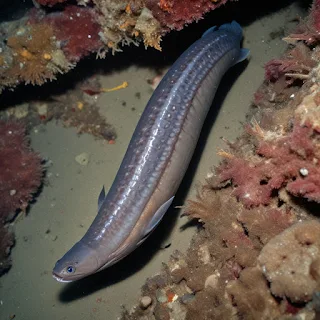General
characteristics and classification of cyclostomes upto class
The Cyclostomata are a modified and degenerate offshoot of the primitive vertebrate lineage. They are named Cyclostomata due to their circular mouths. These creatures are parasitic, typically feeding on fish during their adult stage, and morphologically resemble eels. They are the only living vertebrates without true jaws, which is why they are also known as Agnatha. The Cyclostomata group includes hagfishes and lampreys.
Characteristics
of Cyclostomata
1. The body is round
and elongated, resembling an eel.
2. Paired fins are
absent.
3. Median fins have
cartilaginous fin rays.
4. No paired
appendages.
5. The skin is soft, smooth,
and scale-free.
6. Spleen is absent.
7. The exoskeleton is
absent; the endoskeleton is cartilaginous with no bones.
8. The notochord is
present throughout their lives.
9. The digestive system
lacks a stomach.
10. There is a single,
median nostril.
11. They have five to
sixteen pairs of gills.
12. The heart is
two-chambered.
13. The brain is
visible.
14. The lateral line
functions as a sense organ.
15. About ten pairs of
cranial nerves are present.
16. The sexes are
separate, although some hagfish species may be hermaphroditic.
17. The excretory
system consists of a pair of mesonephric kidneys.
18. Development can be
direct or indirect.
19. Examples include
Petromyzon and Maxine.
Classification of Cyclostomata
The class Cyclostomata
is divided into two orders:
1.
Petromyzonia
2.
Myxinoidea
Order 1: Petromyzonia
1. Includes lampreys.
2. The buccal funnel is
suctorial with horny teeth.
3. The mouth is located
within the buccal funnel.
4. The nasal sac is
dorsal and does not connect with the pharynx.
5. Eyes are functional.
6. Seven pairs of gill
slits are present.
7. A well-developed
dorsal fin is present.
8. The branchial basket
is complete.
9. The brain is
well-developed.
10. The pineal eye is
well-developed.
11. The ear has two
semicircular canals.
Example: Petromyzon
(Sea lamprey), Lampetra fluviatilis.
Order 2: Myxinoidea
1. Includes hagfish or
slime eels.
2. The buccal funnel is
absent.
3. The nasal sac opens
into the pharynx through a canal.
4. Eyes are vestigial.
5. The dorsal fin is
absent or very small.
6. The branchial basket
is poorly developed.
7. The brain is
primitive.
8. The pineal eye is
reduced.
9. The ear has only one
semicircular canal.
10. Hagfish are
exclusively marine.
Example: Myxine glutinosa (Hagfish or slime eel),
Eptatretus (Bdellostoma).







0 Comments